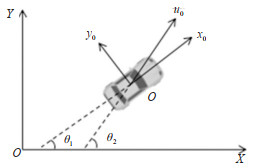Steering Collision Avoidance Control of Intelligent Vehicles for Crossing Pedestrians at Unsignalized Intersections
-
摘要: 针对智能汽车在无信号交叉口对横穿行人的避撞问题,研究了主动转向避撞控制策略。基于多层模型预测控制方法,采用分层控制策略设计局部规划层控制器与全局跟踪层控制器,在此基础上根据交叉口处汽车与行人的轨迹特征计算人车碰撞剩余时间,改进传统人工势场法构造避撞函数,规划出既能规避交叉口内存在碰撞风险的行人又能使偏差最小的局部避撞路径,并使智能汽车在满足多项动力学约束时准确跟踪参考路径,通过搭建CarSim/Simulink联合仿真平台,结合广东省2006—2018年交通事故数据库选取对交叉口人车碰撞有显著影响的因素,设计仿真场景进行仿真分析。结果表明:智能汽车能在多个初始点完成对参考路径的跟踪,控制器对不同速度和附着条件有较高的鲁棒性,高速低附着场景中,智能汽车横向加速度小于0.4 g、质心侧偏角小于2°、前轮侧偏角小于2.5°,各约束量满足舒适性和平稳性条件;4个典型交叉口场景中,智能汽车以不同速度直行或转弯通过交叉口,均能识别横穿行人中存在碰撞风险的行人实现主动转向避撞。Abstract: An active steering collision avoidance control strategy is proposed to cope with pedestrian-vehicle collision avoidance of intelligent vehicles at unsignalized intersections. Based on the multi-layer model predictive control method, the local planning layer controller and the global tracking layer controller are designed by the hierarchical control strategy. On this basis, the remaining time of pedestrian-vehicle collision is calculated according to the trajectory characteristics of vehicles and pedestrians at intersections, and the modified traditional artificial potential field method is employed to construct the collision avoidance function. The local collision avoidance path is planned to minimize the deviation of tracking the global reference path and avoid any pedestrian-vehicle collision at intersections. By CarSim/Simulink co-simulation platform, various scenarios are designed for simulation analysis. The factors that have significant effects on pedestrian-vehicle collision at intersections are selected from the traffic accident database of Guangdong Province from 2006 to 2018. The results show that intelligent vehicles can track the reference path at different initial points, and the controllers have good robustness subjected to different speeds and adhesions. In a high-speed and low-adhesion scenario, the lateral acceleration of intelligent vehicles is less than 0.4 g; the side-slip angle is less than 2°; the front wheel yaw angle is less than 2.5°. At the four typical unsignalized intersections, intelligent vehicles at different speeds can steer to avoid collision for crossing pedestrians when going straight or turning through the intersection.
-
表 1 显著性影响因素
Table 1. Significant influencing factors
影响因素 变量分组 β SE x2 95% CI P 车速/(km/h) 30~45 -0.509 0.210 1 -0.920~-0.098 0.015 45~60 -0.157 0.072 1 -0.297~-0.016 0.028 行驶状态 左转 0.138 0.068 1 0.005~0.271 0.042 右转 0.162 0.073 1 0.019~0.304 0.026 路口区域 湿滑 -0.138 0.055 1 -0.245~-0.030 0.012 路面状况 进口 -0.143 0.069 1 -0.279~-0.007 0.039 表 2 仿真场景参数
Table 2. Parameters of simulation scenario
项目 场景1 场景2 场景3 场景4 车速/(km/h) 30/45/60 30/45/60 30/45/60 30/45/60 汽车行驶路径 匀速直行 匀速直行 匀速右转 匀速左转 进出口 西-东 西-东 南-东 西-北 行人数量 3 3 2 2 横穿汽车路径行人编号 行人1,2 行人1,2 行人1 行人2 路面附着系数μ 0.85 0.4 0.4 0.4 -
[1] 张诗波, 刘澜, 李平飞, 等. 行人致命交通事故特征与致因机理研究: 基于181例深度调查事故案例[J]. 交通信息和安全, 2018, 36(6): 16-23. https://www.cnki.com.cn/Article/CJFDTOTAL-JTJS201806003.htmZHANG Shibo, LIU Lan, LI Pingfei, et al. Characteristics and mechanism of fatal traffic accidents involving pedestrians: based on 181 in-depth investigated cases[J]. Journal of Transport Information and Safety, 2018, 36(6): 16-23. (in Chinese) https://www.cnki.com.cn/Article/CJFDTOTAL-JTJS201806003.htm [2] 王博思, 祖晖, 陈新海, 等. 基于专用短程通信技术DSRC的智能车路协同系统设计和实现[J]. 激光杂志, 2017, 38(6): 147-150. https://www.cnki.com.cn/Article/CJFDTOTAL-JGZZ201706037.htmWANG Bosi, ZU Hui, CHEN Xinhai, et al. Design and implementation of cooperative intelligent transport systems(C-ITS) based on dedicated short range communications(DSRC)[J]. Laser Journal, 2017, 38(6): 147-150. (in Chinese) https://www.cnki.com.cn/Article/CJFDTOTAL-JGZZ201706037.htm [3] 刘少博, 张晖, 吴超仲. TRB2017年会: 行人交通及智能交通研究综述[J]. 交通信息与安全, 2017, 35(3): 1-10. doi: 10.3963/j.issn.1674-4861.2017.03.001LIU Shaobo, ZHANG Hui, WU Chaozhong. A review of 2017 transportation research board 96th annual meeting with the focuses and areas of pedestrian traffic and intelligent transportation[J]. Journal of Transport Information and Safety, 2017, 35(3): 1-10. (in Chinese) doi: 10.3963/j.issn.1674-4861.2017.03.001 [4] World Health Organization. Global status report on road safety 2018[R]. Geneva: World Health Organization, 2018. [5] WANG K, BHOWMIK T, YASMIN S, et al. Multivariate copula temporal modeling of intersection crash consequence metrics: A joint estimation of injury severity, crash type, vehicle damage and driver error[J]. Accident Analysis & Prevention, 2019, 125: 188-197. http://www.sciencedirect.com/science/article/pii/S0001457518308066 [6] YANG W, ZHANG X, LEI Q, et al. Research on longitudinal active collision avoidance of autonomous emergency braking pedestrian system(AEB-P)[J]. Sensors, 2019, 19(21): 4671. doi: 10.3390/s19214671 [7] PARK M K, LEE S Y, KWON C K, et al. Design of pedestrian target selection with funnel map for pedestrian AEB system[J]. IEEE Transactions on Vehicular Technology, 2017, (6615): 3597-3609. http://ieeexplore.ieee.org/document/7556302 [8] FEMANDES L D, MILANES V, PARRA A I, et al. Autonomous pedestrian collision avoidance using a fuzzy steering controller[J]. IEEE Transactions on Intelligent Transportation Systems, 2011, 12(2): 390-401. doi: 10.1109/TITS.2010.2091272 [9] 李素华. 采用dSPACE的电动汽车纵向主动避撞系统研究[J]. 机械设计与制造, 2017(7): 111-114. doi: 10.3969/j.issn.1001-3997.2017.07.028LI Suhua. Research on longitudinal active collision avoidance system of electric vehicles using dSPACE[J]. Mechanical Design & Manufacturing, 2017(7): 111-114. (in Chinese) doi: 10.3969/j.issn.1001-3997.2017.07.028 [10] 赵治国, 胡昊锐, 周良杰, 等. 紧急避撞路径规划及其跟踪驾驶员转向模型[J]. 同济大学学报(自然科学版), 2020, 48(7): 998-1006. https://www.cnki.com.cn/Article/CJFDTOTAL-TJDZ202007009.htmZHAO Zhiguo, HU Haorui, ZHOU Liangjie, et al. Emergency collision avoidance path planning and driver steering tracking model[J]. Journal of Tongji University (Natural Science), 2020, 48(7): 998-1006. (in Chinese) https://www.cnki.com.cn/Article/CJFDTOTAL-TJDZ202007009.htm [11] 邓海鹏, 麻斌, 赵海光, 等. 自主驾驶车辆紧急避障的路径规划与轨迹跟踪控制[J]. 兵工学报, 2020, 41(3): 585-594. https://www.cnki.com.cn/Article/CJFDTOTAL-BIGO202003020.htmDENG Haipeng, MA Bin, ZHAO Haiguang, et al. Path planning and tracking control of autonomous vehicle for obstacle avoidance[J]. Acta Armamentarii, 2020, 41(3): 585-594. (in Chinese) https://www.cnki.com.cn/Article/CJFDTOTAL-BIGO202003020.htm [12] ROSEN E, SANDER U. Pedestrian fatality risk as a function of car impact speed[J]. Accident Analysis & Prevention, 2009, 41(3): 536-542. http://europepmc.org/abstract/med/19393804 [13] 李波. 人在回路的无人驾驶车辆启发式全局路径规划算法研究[D]. 北京: 北京理工大学, 2013.LI Bo. Research on heuristic global path planning algorithm for unmanned vehicles in man in the loop[D]. Beijing: Beijing Institute of Technology, 2013. (in Chinese) [14] 龚建伟, 刘凯, 齐建永. 无人驾驶车辆模型预测控制[M]. 2版. 北京: 北京理工大学出版社, 2019.GONG Jianwei, LIU Kai, QI Jianyong. Model predictive control for self-driving vehicles[M]. 2nd Ed. Beijing: Beijing Institute of Technology Press, 2019. (in Chinese) [15] 陈慧岩, 陈舒平, 龚建伟. 智能汽车横向控制方法研究综述[J]. 兵工学报, 2017, 38(6): 1203-1214. doi: 10.3969/j.issn.1000-1093.2017.06.021CHEN Huiyan, CHEN Shuping, GONG Jianwei. A review on the research of lateral control for intelligent vehicles[J]. Acta Armamentarii, 2017, 38(6): 1203-1214. (in Chinese) doi: 10.3969/j.issn.1000-1093.2017.06.021 [16] 任玥, 郑玲, 张巍, 等. 基于模型预测控制的智能车辆主动避撞控制研究[J]. 汽车工程, 2019, 41(4): 404-410. https://www.cnki.com.cn/Article/CJFDTOTAL-QCGC201904008.htmREN Yue, ZHENG Ling, ZHANG Wei, et al. A study on active collision avoidance control of autonomous vehicles based on model predictive control[J]. Automotive Engineering, 2019, 41(4): 404-410. (in Chinese) https://www.cnki.com.cn/Article/CJFDTOTAL-QCGC201904008.htm [17] 朱西产, 刘智超, 李霖. 基于车辆和行人危险工况的转向避撞控制策略[J]. 汽车安全和节能学报, 2015, 6(3): 217-223. https://www.cnki.com.cn/Article/CJFDTOTAL-QCAN201503003.htmZHU Xichan, LIU Zhichao, LI Lin. Steering collision avoidance control strategy based on vehicle and pedestrian dangerous working conditions[J]. Journal of Automotive Safety and Energy, 2015, 6(3): 217-223. (in Chinese) https://www.cnki.com.cn/Article/CJFDTOTAL-QCAN201503003.htm [18] 葛如海, 肖轩, 洪亮, 等. 交叉路口转弯车辆对横穿行人的避撞策略[J]. 汽车技术, 2021(2): 7-11. https://www.cnki.com.cn/Article/CJFDTOTAL-QCJS202102002.htmGE Ruhai, XIAO Xuan, HONG Liang, et al. Collision avoidance strategy of turning vehicles to crossing pedestrians at intersections[J]. Automobile Technology, 2021(2): 7-11(in Chinese) https://www.cnki.com.cn/Article/CJFDTOTAL-QCJS202102002.htm -





 下载:
下载:
















